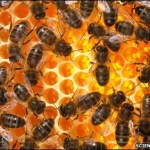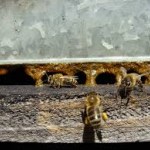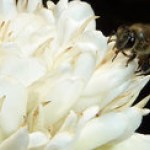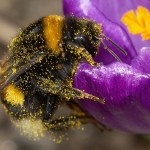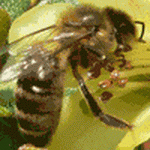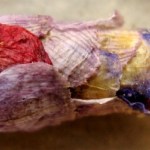bee
Photo by: Leif Richardson, Dartmouth College
I came across this neat press release from the University of Massachusetts:
AMHERST, Mass. – Researchers studying the interaction between plants, pollinators and parasites report that in recent experiments, bees infected with a common intestinal parasite had reduced parasite levels in their guts after seven days if the bees also consumed natural toxins present in plant nectar.
In this early and most comprehensive study of its kind, researchers at the University of Massachusetts Amherst and Dartmouth College studied hundreds of eastern bumblebees…
Bee at Backreaction has been busy over the last few months, here is my backlog reading list:
A Thousand Words
Do we live in a computer simulation?
Consciousness and Physics from Scratch
10 things I wish I had known 20 years ago
Science changed my life and yours too
Do we write too many papers?
Frequently Asked Questions
No, the long sought-after link between the theories of quantum mechanics and general relativity has not been found
Does the scientific method need revision?
It is a good starting point, if you're not reading Backreaction already.
Varroa mites can be highly destructive to bee colonies and are a big concern for beekeepers. They get inside honeycombs where they lay eggs and feed on the bee pupae. When the adult bees are released from their cells, so are the mites, which then go on to lay more eggs. Bees that live with these mites are usually smaller and prone to a disease known as deformed wing virus. The presence of the mites and the disease can decimate an entire hive.
Image of Varroa mite on a honeybee from Wikipedia
Dr. Francis Ratnieks (University of Sussex, Brighton) observed 42 honeybee colonies and discovered…
Image from APiS UK
Propolis is a resin-like compound honeybees collect to coat their hives. New research suggests that this compound may increase hair growth as observed in studies of mice. Although the researchers did not test propolis on balding mice, they did find faster hair growth in mice that had been shaved or waxed, which is somewhat promising.
Source:
Miyata S, Oda Y, Matsuo C, et al. Stimulatory Effect of Brazilian Propolis on Hair Growth through Proliferation of Keratinocytes in Mice.J. Agric. Food Chem. 2014.
A frightening fraction of my open tabs are some of Bee's posts at Backreaction - so to save my browsers, I dump them here for further future perusal:
Are irreproducible scientific results okay and just business as usual?
Shut up and let me think
Should the Nobel Prize be given to collaborations and institution?
Women in Science, Again?
Science Martketing needs Consumer Feedback
Does Modern Science Discourage Creativity?
The comeback of massive gravity?
Can Planck Stars Exist?
Book review: “The Theoretical Minimum – Quantum Mechanics” By Susskind and Friedman
Do we live in a…
Honeybee visiting a coffee flower, photo from Geraldine Wright
Apparently humans and honeybees share something in common when it comes to caffeine. Dr. Geraldine Wright (Newcastle University, England) discovered that bees are more likely to return to flowers that produce nectar containing caffeine. Their data suggest caffeine improves memory in bees. Caffeine is present in higher concentrations in the leaves and other tissues of the plant where it provides the added benefit of warding off predators.
According to a quote from The New York Times by Dr. Robert a Raguso at…
Image from: Wikipedia, P7r7
New research from Dr. Daniel Robert and colleagues at the University of Bristol shows that bees are not only attracted to the bright colors and smells of flowers, they can also sense their electrical field.
It has been known that bees develop positive charges as they bump into small charged molecules during flight, resulting in a loss of electrons from their surface. In contrast, flowers accumulate negative charges on their petals as they lose positive charges to the surrounding air. The interaction between a positively charged bee and a negatively charged…
Image from: http://Phys.Org
Not only do bees sting, but they also bite victims that are too small for stingers (ex: wax moth larva that invade the beehive and eat pollen) and paralyze them for up to nine minutes by secreting 2-heptanone into the wound. This paralysis gives the bees time to remove the invaders from the beehive. Dr. Papachristoforou and his team at Aristotle University of Thessaloniki in Greece discovered the paralyzing effects of the honeybee bite while studying wax moth larvae that invade the beehives. Their data suggest that this chemical may be an effective…
Given the recent elephant hunting scandal, I thought I'd repost this award-winning piece from the archives, on a very clever way to deter elephants from raiding human settlements. Much cleverer than shooting them. (Click on the archives icon for the original.)
What information is contained in the call of a mammal? Some calls might reflect the internal emotional state of the animal, like fear or anxiety, or they can refer to an external object, agent, or event, like the presence of a predator. Rhesus monkeys, lemurs, baboons, and guinea pigs, for example, will produce calls when separated from…
NPR reports on the discovery of a bee that builds tiny, multi-coloured nests out of flower petals. The rare solitary bee Osmia avoseta creates the cocoons out of a mixture of mud, flower petals and nectar. Each case holds a single egg.
The discovery by a group of scientists in Turkey co-incided with that of another team in Iran; the two groups published their findings together in the American Museum Novitae. More pictures and info on NPR.org.
What information is contained in the call of a mammal? Some calls might reflect the internal emotional state of the animal, like fear or anxiety, or they can refer to an external object, agent, or event, like the presence of a predator. Rhesus monkeys, lemurs, baboons, and guinea pigs, for example, will produce calls when separated from their conspecifics or in the presence of a stranger. Howler monkeys produce specific alarm calls for avian predators, even when they have never encountered an avian predator for several generations. Vervet monkeys produce different calls in response to…
A few weeks back we brought you a story on the Schmidt Sting Pain Index, a system developed to compare the relative intensity of Hymenoptera (bees, wasps and ants) stings. The index was developed through personal "research" conducted unintentionally by Dr. Justin Schmidt, an entomologist who has devoted his life to these ornery critters.
As the Index combines all the things Zooillogix readers love (i.e. science and non-life threatening personal injury) the response to the post was strong. Therefore in collaboration with Shelley Batts, formerly of Retrospectacle and now the brand new…
